OSI Model
OSI Model
(Open Systems Interconnection
model) The International Standards Organization's OSI model serves as a
standard template for describing a network protocol stack.
The Protocol Stack
Using TCP/IP as a model, the sending
application hands data to the transport layer, which breaks it up into the
packets required by the network. It stores the sequence number and other data
in its header. The network layer adds source and destination data in its
header, and the data link layer adds station data in its header. On the other
side, the corresponding layer reads and processes the headers and discards
them.
Upper Layers
Layers 7 through 4 comprise the upper layers of
the OSI protocol stack. They are more geared to the type of application than
the lower layers, which are designed to move packets, no matter what they
contain, from one place to another.
Application Layer 7
This top layer defines the language and syntax
that programs use to communicate with other programs. The application layer
represents the purpose of communicating in the first place. For example, a
program in a client workstation uses commands to request data from a program in
the server. Common functions at this layer are opening, closing, reading and
writing files, transferring files and e-mail messages, executing remote jobs
and obtaining directory information about network resources.
Presentation Layer 6
When data are transmitted between different
types of computer systems, the presentation layer negotiates and manages the
way data are represented and encoded. For example, it provides a common
denominator between ASCII and EBCDIC machines as well as between different
floating point and binary formats. Sun's XDR and OSI's ASN.1 are two protocols
used for this purpose. This layer is also used for encryption and decryption.
Session Layer 5
Provides coordination of the communications in
an orderly manner. It determines one-way or two-way communications and manages
the dialog between both parties; for example, making sure that the previous
request has been fulfilled before the next one is sent. It also marks
significant parts of the transmitted data with checkpoints to allow for fast
recovery in the event of a connection failure.
In practice, this layer is often not used or
services within this layer are sometimes incorporated into the transport layer.
Transport Layer 4
This layer is responsible for overall end-to-end
validity and integrity of the transmission. The lower layers may drop packets,
but the transport layer performs a sequence check on the data and ensures that
if a 12MB file is sent, the full 12MB is received.
"OSI transport services" include layers
1 through 4, collectively responsible for delivering a complete message or file
from sending to receiving station without error.
Lower Layers
Layers 3 through 1 are responsible for moving
packets from the sending station to the receiving station.
Network Layer 3
The network layer establishes the route between
the sender and receiver across switching points, which are typically routers.
The most ubiquitous example of this layer is the IP protocol in TCP/IP. IPX, SNA and AppleTalk are other examples of
routable protocols, which means that they include a network address and a
station address in their addressing system. This layer is also the switching
function of the dial-up telephone system. If all stations are contained within
a single network segment, then the routing capability in this layer is not
required.
Data Link Layer 2
The data link is responsible for node to node
validity and integrity of the transmission. The transmitted bits are divided
into frames; for example, an Ethernet, Token Ring or FDDI frame in local area
networks (LANs). Frame relay and ATM are also at Layer 2. Layers 1 and 2 are
required for every type of communications.
Physical Layer 1
The physical layer is responsible for passing
bits onto and receiving them from the connecting medium. This layer has no
understanding of the meaning of the bits, but deals with the electrical and
mechanical characteristics of the signals and signaling methods. For example,
it comprises the RTS and CTS signals in an RS-232 environment, as well as TDM
and FDM techniques for multiplexing data on a line. SONET also provides layer 1
capability.
OSI Model
|
Layer
#
|
Name
|
Mnemonic
|
Encapsulation
Units
|
Devices
or Components
|
Keywords/Description
|
|
7
|
Application
|
All
|
data
|
PC
|
Network
services for application processes, such as file, print, messaging, database
services
|
|
6
|
Presentation
|
People
|
data
|
|
Standard
interface to data for the application layer. MIME encoding, data encryption,
conversion, formatting, compression
|
|
5
|
Session
|
Seem
|
data
|
|
Interhost
communication. Establishes, manages and terminates connection between
applications
|
|
4
|
Transport
|
To
|
segments
|
|
End-to-end
connections and reliability. Segmentation/DE segmentation of data in proper
sequence. Flow control
|
|
3
|
Network
|
Need
|
packets
|
router
|
Logical
addressing and path determination. Routing. Reporting delivery errors
|
|
2
|
Data
Link
|
Data
|
frames
|
bridge,
switch, NIC
|
Physical
addressing and access to media. Two sub layers: Logical Link Control (LLC)
and Media Access Control (MAC)
|
|
1
|
Physical
|
Processing
|
bits
|
repeater,
hub, transceiver
|
Binary
transmission signals and encoding. Layout of pins, voltages, cable
specifications, modulation
|
OSI comparison with TCP/IP Protocol Stack
|
OSI
#
|
OSI
Layer Name
|
TCP/IP
#
|
TCP/IP
Layer Name
|
Encapsulation
Units
|
TCP/IP
Protocols
|
|
7
|
Application
|
4
|
Application
|
data
|
FTP,
HTTP, POP3, IMAP, telnet, SMTP, DNS, TFTP
|
|
6
|
Presentation
|
data
|
|
||
|
5
|
Session
|
data
|
|
||
|
4
|
Transport
|
3
|
Transport
|
segments
|
TCP,
UDP
|
|
3
|
Network
|
2
|
Internet
|
packets
|
IP
|
|
2
|
Data
Link
|
1
|
Network
Access
|
frames
|
|
|
1
|
Physical
|
bits
|
|




Comments
Post a Comment